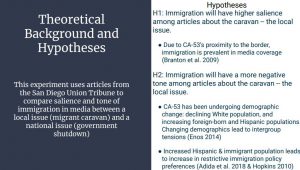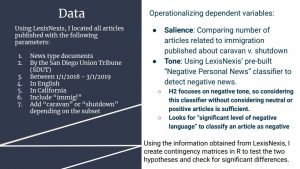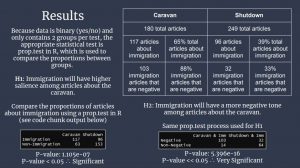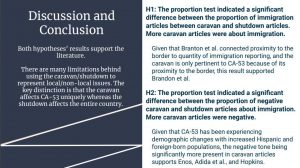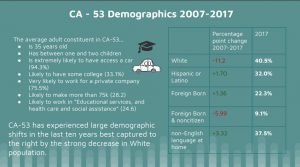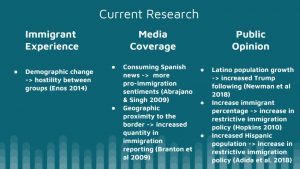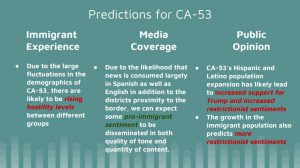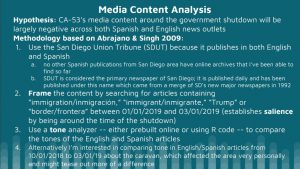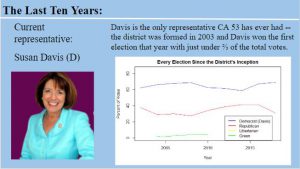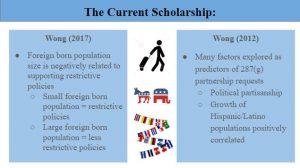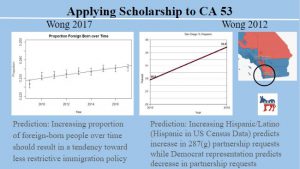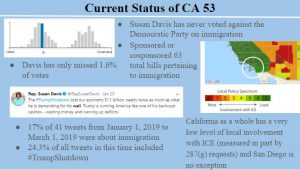Below is my op-ed regarding how Susan Davis should adjust her strategy to focus on local, rather than national, issues in order to represent immigrants better in her district. See the Abstract below for a comprehensive summary of my approach.
Immigration in CA-53: Recommendations for Susan Davis
Abstract
Susan Davis, the congressional representative of CA-53, treats immigration as an important issue and is historically in favor of humanitarian and pro-immigration efforts. Much of the work mentioned under the “Immigration” tab on her website is in response to national immigration issues; however, there is room for improvement on support of local issues. Current scholarship indicates that districts like CA-53 — districts that are undergoing demographic changes, especially those observed in CA-53, and are close to the border geographically — are prone to intergroup tensions. I performed a media content analysis of the San Diego Union Tribune (SDUT) and concluded that San Diego, and subsequently CA-53, may be currently experiencing these tensions in line with current scholarships predictions. Davis’ support for immigration on a national level is excellent, but more emphasis on its local implications is prudent.
Existing Scholarship
Current scholarship, as well as common sense, primes immigration to be a highly salient topic in regions close to the international border (Branton et al. 2009). CA-53 has been experiencing some demographic shifts communicated to researchers in the differences between the demographics reported in 2007 and 2017 according to the US Census Bureau’s American Fact Finder. Specifically, CA-53 has experienced a large decrease in White, small increase in Hispanic or Latino, and small increase in immigrant populations. Pertinent to these changes in CA-53: scholarship indicates that changing demographics lead to intergroup tensions and increased Hispanic and immigrant populations both lead to increased hostility over immigration. (Enos 2014, Adida et al. 2018, Hopkins 2010).
Susan Davis’ Current Actions
An exploratory look into Davis’ website clearly indicates her strong support for immigration, with support for DREAMers and Middle Eastern refugees taking up the bulk of the page. On the Related News section beneath the page, only 1 out of 5 stories is decidedly local: “Congresswoman Susan Davis’ Statement on the Closing of the San Ysidro Point of Entry.” It would appear that Davis’ pro-immigration sentiments largely fall under the scope of national policy interests.
My Research
I performed a media content analysis, meaning that I took a form of media (SDUT) and wanted to compare saliency and tone of immigration in local and national scopes. Saliency here means I was interested in how often immigration was discussed in terms of local issues vs national issues. Tone here means I was looking at how negative the articles about immigration were on local vs national issues. My analysis, which can be seen in full here, indicates that immigration is an especially salient topic on a local level in CA-53, even greater than on a national level. A larger percentage of local articles on a specified topic included immigration than national articles on a comparable topic. Potentially even more impactive, sentiment of local immigration articles was significantly more negative than sentiment of national immigration articles. Understanding that media outlets pander to their viewers’ beliefs politically, these results indicate that CA-53 is in line with scholarship and is feeling intergroup tensions from the demographic change of the last ~12 years.
Results
The scholarship indicates that districts resembling CA-53 experience negative intergroup sentiments and attitudes towards immigration. My media content analysis indicates that CA-53 is more inclined to feel local tensions pertaining to immigration on a local scale than immigration on a national scale. Both the scholarship and my research are in agreement that CA-53 constituents observe local immigration issues as more important than national immigration issues and that there is some tension regarding local immigration issues.
Recommendation
Davis’ existing strategy — focus on immigration at the national level — is not a bad strategy in terms of working for change. She has experienced success in this arena by cosponsoring comprehensive legislation that have gained traction in both parties. Her behavior on a national scope is in line with her constituents’ beliefs: favoring national over local immigration.
However, if Davis is interested in serving the immigrants in her district better, she should address tensions within her home district and increase her involvement in local immigration issues. These shifts would need to be done with care considering it is an approach that may make some of her constituents uneasy, but her continued success in CA-53 elections indicates that she can afford to take this stance without worrying about reelection.
Erring on the side of caution: given that increasing Davis’ presence in the local immigration conversations may be politically risky in terms of constituents feeling tension: I have included two lists of recommendations. One, entitled “Shifts,” is moderate adjustments that require little change. The latter, entitled “Changes,” is less moderate and more intense in terms of change required.
Shifts
- Continue to advocate for immigration reform at the national level
- Continue to vote in favor of positive immigration reform
- Occasionally attend events held by — and meet with coordinators of — local immigrant activist groups (Welcoming San Diego, Ready Now San Diego, Border Angels, etc)
- Balance issues between local concerns/national concerns on the immigration tab of Davis’ website OR include discussion of local implications of national issues
Changes
All actions delineated above in addition to:
- Recruit immigrant interns/staff
- Regularly work to populate “Immigration Events” in the website calendar (currently none scheduled nor any past events listed)
- Speak publicly on the importance of welcoming immigrants in our community
- Standing in opposition to organizations that threaten immigrants regardless of legal status
I include eight recommendations here on two different levels of magnitude to increase the likelihood of one or two being enacted and to emphasize the importance of increasing support for local immigration efforts.
I pledge my honor this paper represents my own work in accordance with University regulations. – Tabitha Lynne Belshee

